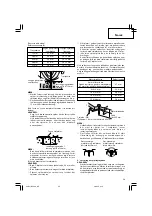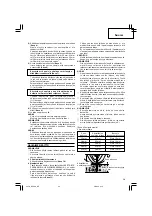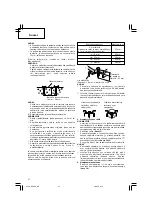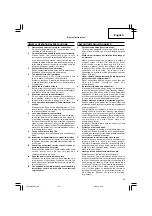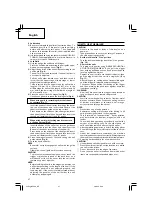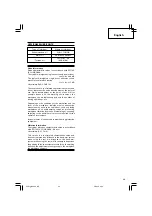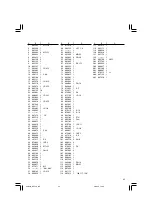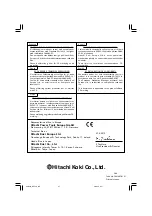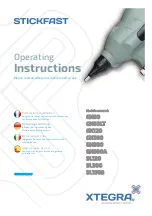
38
English
[Attaching wood to concrete]
Reference Examples
NOTE:
䡬
When attaching wood to concrete, test-fire one nail
into soft concrete. If the concrete is too hard, the nail
may bend or not be driven in sufficiently.
䡬
There are cases in which nails will not be properly
driven into concrete with an intrusion level deeper
than 15mm or hard concrete.
[When attaching thin steel plates (equally-partitioned
runners) to concrete]
WARNING:
Ensure that special nails are used when attaching
thick steel plates to concrete.
Failure to observe this may result in the nail not
being driven into the concrete, or in it bending or
ricocheting out, which may lead to injury.
NOTE:
Only use runners or other grooved steel plates when
driving special concrete nails into concrete. Also, as
the material is thin, it is necessary to adjust the depth
with the adjustor to ensure that it is equal with the
surface
(2) Selecting hardened nails for steel plates
CAUTION
䡬
Use C-beam steel with a thickness of 3.2 mm or less.
䡬
Use hardened nails designed for use with steel plating.
䡬
Place the nailer vertically over the location into which
the nail is to be driven.
䡬
When galvanized steel or other metal plates are to be
attached directly onto C-beam steel, make sure they
are 0.7 mm or less in thickness.
Also, make sure that nails designed for use with steel
plating with a length of 27 mm are used.
䡬
Do not use the nailer on roofs or ceilings.
䡬
Make sure that the thickness of the hardened nails
designed for use with steel plating are of the correct
thickness for the C-beam steel.
If the nail is longer than the thickness of the material, it
may result in it not being driven into C-shaped steel or in
it bending, which could lead to injury.
Select the appropriate nail length in accordance with the
illustration shown in the next section.
NOTE:
䡬
Holding power will be greatly decreased if nails are
driven too hard into steel plating, adjust the driving
depth of the nail by the adjuster.
䡬
There are cases in which the nails will not be driven
in sufficiently depending on a combination of the
hardness and thickness of the C-beam or material.
3. Adjusting the nail-driving depth
CAUTION
When making adjustments, be sure remove your
finger from the trigger. When making adjustments,
be sure that the nail outlet is not facing downward
and that body parts or other people are not in the
path of the nail outlet.
Length of Nails
to be Used
Wood Thickness
Concrete Intrusion
Depth 10 to 15 mm
Material Thickness
Nail Length
9 mm or less
Galvanized iron and other metal plates
27 mm
0.7 mm or less (direct attachment)
9 to 12 mm
32 mm
10 to 27 mm
38 mm
14 to 35 mm
45 mm
15 to 40 mm
50 mm
C-beam Steel
(Thickness: 1.6 mm to a
maximum of 3.2 mm)
Material Thickness
Approximately
10 to 35 mm
The external material
and steel plating is not
deformed.
The external material
and steel plating is
deformed.
Thin steel sheets
Concrete intrusion level
of 18 mm to 24 mm.
Wood
Length of Nails
Concrete
Thickness
to be Used
Intrusion Depth
15 mm
27 mm
Approx. 12 mm
20 mm
32 mm
Approx. 12 mm
25 mm
38 mm
Approx. 13 mm
30 mm
45 mm
Approx. 15 mm
35 mm
50 mm
Approx. 15 mm
05Eng_NC50H_NE
4/26/12, 9:42
38
Содержание NC 50H
Страница 45: ...44 06Back_NC50H_NE 4 26 12 9 17 44 ...
Страница 46: ...45 06Back_NC50H_NE 4 26 12 9 17 45 ...
Страница 47: ...46 06Back_NC50H_NE 4 26 12 9 17 46 ...

